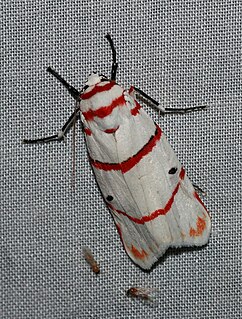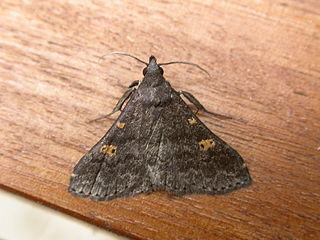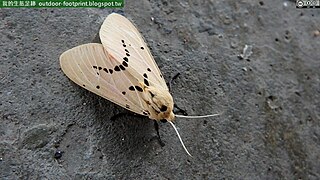
The Arctiinae are a large and diverse subfamily of moths with around 11,000 species found all over the world, including 6,000 neotropical species. This subfamily includes the groups commonly known as tiger moths which usually have bright colours, footmen which are usually much drabber, lichen moths, and wasp moths. Many species have "hairy" caterpillars that are popularly known as woolly bears or woolly worms. The scientific name Arctiinae refers to this hairiness. Some species within the Arctiinae have the word tussock in their common name because they have been misidentified as members of the Lymantriinae subfamily based on the characteristics of the larvae.

The Arctiini are a tribe of tiger moths in the family Erebidae.

Creatonotos is a genus of tiger moths in the family Erebidae. The moths in the genus are found in the Afrotropics, South and East Asia, Sundaland and Australia.

Cyana is a genus of moths in the family Erebidae. Species are well distributed in Africa, Madagascar, China, India, Sri Lanka, Myanmar, Sumatra, Java and Borneo. The genus was erected by Francis Walker in 1854.

Naarda is a large genus of erebid moths currently encompassing 108 species. Initially identified by Francis Walker in 1866, it is in the family Erebidae. Somewhat ruddy in appearance, this genus is distinguishable for its generally slender thorax and abdomen, and straight, porrect labial palpi. Most species are a light tan color, but shading can reach as deep as a charcoal, with muddy yellow, conspicuous reniform, orbicular stigmata featured on the forewings, sometimes reflected bilaterally superior.

Lyclene is a genus of lichen moths of the family Erebidae, subfamily Arctiinae. The genus was erected by Frederic Moore in 1860.
Satara is a genus of moths in the family Erebidae from Sulawesi and South India. The genus was erected by Francis Walker in 1865.
Sicciaemorpha is a genus of moths in the subfamily Arctiinae. It contains seven species, which are found in eastern Asia.

Spilarctia is a genus of moths in the family Erebidae. The genus was erected by Arthur Gardiner Butler in 1875.

Virbia is a genus of tiger moths in the family Erebidae. The genus was erected by Francis Walker in 1854.

Lyclene reticulata is a species of lichen moths of the family Erebidae, subfamily Arctiinae. It is found in Queensland, Australia, as well as on Ambon, Seram, Timor, Batchian, Aru, Tobriand, the Louisiade Archipelago and the Dampier Archipelago,
The Micronoctuini are a tribe of moths in the family Erebidae that includes about 400 described species. Typical species in the tribe have bifine hindwing venation and are smaller than those in other noctuoid moths. Micronoctua karsholti is the smallest of all species in the superfamily Noctuoidea.

The Nyctemerina are a subtribe of woolly bear moths in the family Erebidae.

Somena scintillans, the yellow tail tussock moth, is a moth in the family Erebidae described by Francis Walker in 1856. It is found in northern India, Sri Lanka, Myanmar and the Andaman Islands. Though considered a minor pest, larva can sporadically be a serious pest.
Chrysoscota vagivitta is a moth of the family Erebidae. It was described by Francis Walker in 1866. It is found on Misool, Seram and New Guinea.

Macrobrochis gigas is a moth of the family Erebidae. It was described by Francis Walker in 1854. It is found in China (Yunnan), India (Sikkim), Bhutan, Nepal, Indonesia, Hong Kong and Taiwan. The habitat consists of woodlands.
Nyctemera radiata is a moth of the family Erebidae first described by Francis Walker in 1856. It is found in the Philippines.
Sicciaemorphaivyalba is a moth in the subfamily Arctiinae.

Barsine cuneonotata, the footman moth, is a moth of the subfamily Arctiinae. The species was first described by Francis Walker in 1855. It is found in China, Thailand, India, Sri Lanka, Sumatra, Borneo, Singapore and the Philippines,
Barsine defecta is a moth of the family Erebidae first described by Francis Walker in 1854. It is found in Sri Lanka, Nepal, Thailand and Vietnam. It is the type species of genus Barsine.












